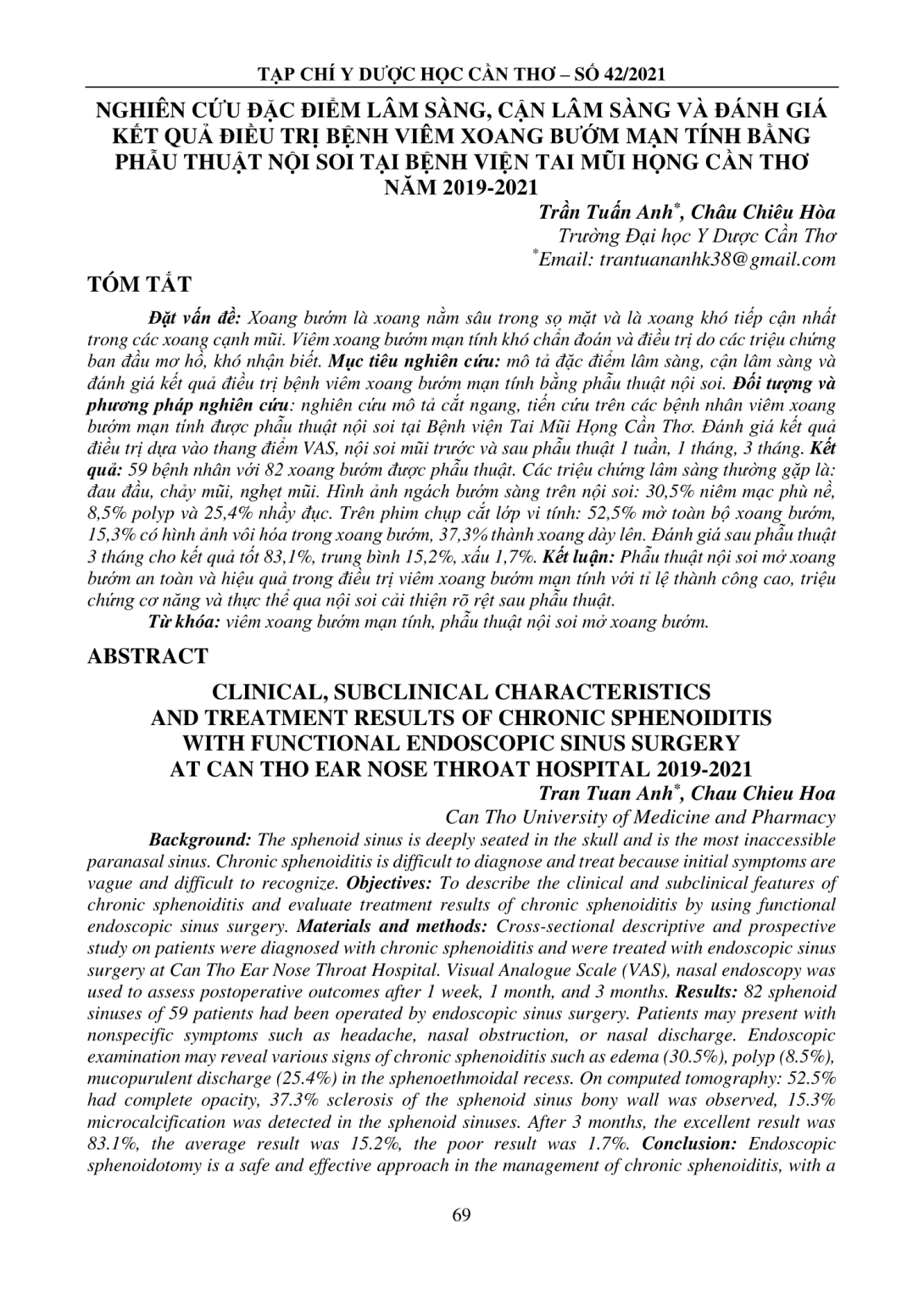
Xoang bướm là xoang nằm sâu trong sọ mặt và là xoang khó tiếp cận nhất trong các xoang cạnh mũi. Viêm xoang bướm mạn tính khó chẩn đoán và điều trị do các triệu chứng ban đầu mơ hồ, khó nhận biết. Mục tiêu nghiên cứu: mô tả đặc điểm lâm sàng, cận lâm sàng và đánh giá kết quả điều trị bệnh viêm xoang bướm mạn tính bằng phẫu thuật nội soi. Đối tượng và phương pháp nghiên cứu: nghiên cứu mô tả cắt ngang, tiến cứu trên các bệnh nhân viêm xoang bướm mạn tính được phẫu thuật nội soi tại Bệnh viện Tai Mũi Họng Cần Thơ. Đánh giá kết quả điều trị dựa vào thang điểm VAS, nội soi mũi trước và sau phẫu thuật 1 tuần, 1 tháng, 3 tháng. Kết quả: 59 bệnh nhân với 82 xoang bướm được phẫu thuật. Các triệu chứng lâm sàng thường gặp là: đau đầu, chảy mũi, nghẹt mũi. Hình ảnh ngách bướm sàng trên nội soi: 30,5% niêm mạc phù nề, 8,5% polyp và 25,4% nhầy đục. Trên phim chụp cắt lớp vi tính: 52,5% mờ toàn bộ xoang bướm, 15,3% có hình ảnh vôi hóa trong xoang bướm, 37,3% thành xoang dày lên. Đánh giá sau phẫu thuật 3 tháng cho kết quả tốt 83,1%, trung bình 15,2%, xấu 1,7%. Kết luận: Phẫu thuật nội soi mở xoang bướm an toàn và hiệu quả trong điều trị viêm xoang bướm mạn tính với tỉ lệ thành công cao, triệu chứng cơ năng và thực thể qua nội soi cải thiện rõ rệt sau phẫu thuật.
The sphenoid sinus is deeply seated in the skull and is the most inaccessible paranasal sinus. Chronic sphenoiditis is difficult to diagnose and treat because initial symptoms are vague and difficult to recognize. Objectives: To describe the clinical and subclinical features of chronic sphenoiditis and evaluate treatment results of chronic sphenoiditis by using functional endoscopic sinus surgery. Materials and methods: Cross-sectional descriptive and prospective study on patients were diagnosed with chronic sphenoiditis and were treated with endoscopic sinus surgery at Can Tho Ear Nose Throat Hospital. Visual Analogue Scale (VAS), nasal endoscopy was used to assess postoperative outcomes after 1 week, 1 month, and 3 months. Results: 82 sphenoid sinuses of 59 patients had been operated by endoscopic sinus surgery. Patients may present with nonspecific symptoms such as headache, nasal obstruction, or nasal discharge. Endoscopic examination may reveal various signs of chronic sphenoiditis such as edema (30.5%), polyp (8.5%), mucopurulent discharge (25.4%) in the sphenoethmoidal recess. On computed tomography: 52.5% had complete opacity, 37.3% sclerosis of the sphenoid sinus bony wall was observed, 15.3% microcalcification was detected in the sphenoid sinuses. After 3 months, the excellent result was 83.1%, the average result was 15.2%, the poor result was 1.7%. Conclusion: Endoscopic sphenoidotomy is a safe and effective approach in the management of chronic sphenoiditis, with a high success rate, symptoms, and nasal endoscopic signs were improved significantly after surgery.
- Đăng nhập để gửi ý kiến
